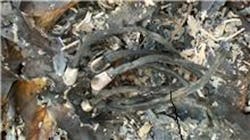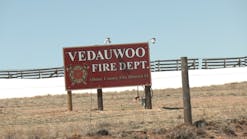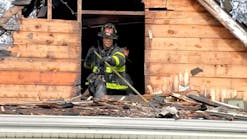As the spring fire season approaches, fire investigators across the country will be responding to wildfires to conduct origin and cause investigations. In many jurisdictions, investigators are assigned to a type of investigation that is unfamiliar. During the response, the investigator may be thinking that it is no big deal, having already investigated hundreds of structure fires. How hard can a wildfire be? The answer is simple; you must be trained in wildfire investigation to understand the process. If the investigator has no formal training as a wildland firefighter then you need to expand your education in this field.
The National Fire Academy offers training programs including S-130 and S-190 and can be completed through online study. The S-130 is the basic wildland firefighter training and the S-190 is an introduction to wildland fire behavior. These two training programs will certify the investigator to the National Wildfire Coordinating Group’s (NWCG) standard as a basic wildland firefighter.
Local investigators must understand that this type of investigation requires special training and certifications to perform a competent fire investigation. A few years ago, I enrolled in the FI- 210, Wildland Fire Origin and Cause Determination. This class was instructed by members of the New Jersey Forest Fire Service and the commitment and professionalism by these instructors was second to none. FI-210 will give the investigator a solid foundation on how to correctly investigate a wildfire. If you are involved in investigations and have the potential to respond to a wildfire, then S-130, S-190 and FI -210 are strongly recommended.
Part 1 of this article will hit the main points for the local investigator to focus on, not the seasoned wildfire investigator. Remember, becoming familiar with this type of investigation takes hours of additional training and on-scene time is required.
Safety
As always, safety is our first concern! A minimum of two investigators should be assigned to the incident. Always operate under the incident management system and remain in constant communication with fire suppression units at the scene. Become familiar with the fireline handbook and ensure that you follow the standard firefighting orders and watch-out situations. Use all your personal protective equipment (PPE) that was issued. The proper use of PPE can save your life if fire conditions change.
A wildfire is a dynamic event where many different strategies and tactics are employed. Be sure to monitor the radio for changing fire conditions and weather reports. Your escape route must be constantly evaluated and always have a backup plan if necessary. Be aware of aircrafts conducting air drops and heavy equipment operating in the area. Conducting investigations near railroads, power lines and roadways can be deadly; always stay alert and monitor your surroundings. Remember, it is critical that the investigator adheres to all safety policies established by local, state and federal agencies.
Methodology
Investigating wildfires is a complex endeavor using science, knowledge, skill and technology. Whether it’s a structure, vehicle or wildfire, investigators must use a systematic approach. Often the use of the systematic approach will uncover new data for analysis. The systematic approach identified in the NFPA 921, Guide for Fire and Explosion Investigations is the scientific method. The use of the scientific method will provide the investigator with an organizational process to succeed at a fire investigation. The scientific method is broken down into seven steps.
- Recognize the need
- Define the problem
- Collect data
- Analyze data
- Develop a hypothesis
- Test the hypothesis
- Select the final hypothesis
As a fire investigator, you should be familiar with and use the scientific method.
Wildfire Behavior Factors
As a fire investigator, it is critical to understand the basic principles of fire behavior and fire-spread development. There are three main factors that relate to fire spread and development of a wildfire. The factors are weather, topography and fuels. The investigator must understand how these elements effect the formation of indicators to interpret burn patterns correctly.
Weather – When we talk about weather, the investigator should review three elements. The elements of weather are wind, relative humidity and temperature. The wind has the greatest outcome on fire-spread development and growth. As the fire becomes larger, it will begin to create its own wind. Remember that wind can change directions quickly and have an effect on fire patterns. Relative humidity has a direct effect on ignition and intensity. The temperature may dry and preheat any fuels.
Topography – Topography is also broken down into three areas; slope, aspect and terrain. We know that wind has a significant effect on the outcome of wildfires; however, understanding the slope is essential. Remember that fires will accelerate faster uphill then downhill. As the fire burns uphill, it preheats all fuels in the area. This can become extremely dangerous. Investigators should consider the aspect of the slope. The aspect is the direction that the slope faces. The southwest facing slope will heat faster than the northeast. The terrain affects the intensity and spread of the fire. If barriers are in the area they can cause the fire to slow down or extinguish.
Fuels – Fuels are classified by type, size, arrangement and fuel moisture. Remember, fire will ignite and spread rapidly in dead fuels with a low-moisture content.
Fire-Spread Principles
For a fire to occur there must be an ignition source that contacts the fuel and maintains sufficient heat to raise the fuel to its ignition temperature. The location of the ignition source and the first material ignited is classified as the point of origin. Many times physical remains of an ignition source will be located at this exact point, as shown in photo 1. The fire will move outward from the point of origin moving in a circular direction. At this point, the fire will begin to be influenced by any fuels in the area and the wind direction and slope. As the fire starts to spread it will be slow and be at a low intensity. The area that surrounds the point of origin is classified as the specific origin. As fire grows in size it will come under the influence of fire behavior factors. The fire will start to become uneven and begin to intensify. This area is classified as the general origin of the fire. The fire will start to have characteristics and fire-direction indicators are formed. These fire-direction indicators are called vectors. The vectors are as followed:
Advancing fire – The advancing fire is commonly referred to as the head fire or front. The head fire is the most intense burning. Indicators with the advancing fire are large and noticeable.
Backing fire – The backing fire is commonly referred as the heel or rear of the fire. The backing fire is usually downslope or against the wind. Indicators with the backing fire are less noticeable and smaller.
Lateral fire – The lateral fire is commonly referred as the side or flank of the fire. The lateral fire spreads at a 45- to 90-degree angle from the main direction of the fire. Indicators with the lateral fire can have the same identifiers as the advancing and backing fire.
Fire-Direction Indicators
During the progression of the fire, visible markings will be left on non-combustible and combustible objects. These markings are classified as the fire-direction indicators. Remember that indicators are present on small and large objects and fuel. The investigator should work from the area of most intense burning to the least intense burning. Remember, the indicators become less pronounced as you get closer to the point of origin. This method is the accepted standard for wildfire investigation. Fire-direction indicators are classified into 14 categories. A full list of fire-direction indicators are listed in NFPA 921 and the National Wildfire Coordinating Group Origin and Cause Handbook. We will briefly discuss the 14 indicators below.
- Protection: Fuels will be unburned on the non-origin side (as shown is Photo 2)
- Grass stems: Remains will appear different depending on fire travel
- Foliage freeze: Accurate indicator of wind direction only
- Degree of damage: The amount of fire-related damage to a combustible object (as shown in Photo 3)
- Depth of char: Color and size has no bearing on fire intensity
- Angle of char: Fire patterns will be foliage or trunks
- Spalling: Caused by the breakdown of the surface of rocks exposed to heat
- Curling: Leaves and vegetation will curl inwards towards source of heat
- Sooting: Occurs on the origin side of the fire
- Staining: Non-combustible objects effected on origin side of fire (as shown in photo 4)
- White ash: Product of complete combustion
- Cupping: Associated with small-diameter fuels
- V-patterns: The area of origin may near the point of V (best viewed from aircraft)
- Die-out patterns: Areas where fire died out on its own
Conclusion
The wildfire investigation is a challenge for any fire investigator. If you have the opportunity to assist with an investigation, you will be exposed to a different technique of interpreting fire patterns. Remember to work from the area of most intense burning, to the area of the least intense burning. Make sure to follow the burn-pattern indicators, as you may find multiple points of origin. Remember to take your time and do not rush the investigation by pre-judging the area of origin or cause of the fire. Become familiar with the fire-line handbook and ensure you follow the standard firefighting orders and watch out situations. Enroll in S-130/S-190 and FI-210. The educational experience is excellent and it will make you a better investigator.
References
- NFPA 921, Guide for Fire and Explosion Investigations, 2008 ed. Quincy, MA: National Fire Protection Association, 2008. Print.
- Wildfire Origin & Cause Determination Handbook, 2005 ed. National Wildfire Coordinating Group, 2005. Print.
ROBERT DISBROW JR. IAAI-CFI is a 22-year veteran of the fire service. Rob is a career firefighter/investigator with the City Of Bayonne, NJ, Fire Department and also conducts origin and cause investigations for a forensic engineering firm based in New Jersey. He is a life member of the Laurelton Fire Co. # 1 and a fire commissioner for the Howell Township Fire District # 1. Rob holds an associate degree in fire science and is a IAAI-CFI certified fire investigator and NAFI -CFEI certified fire and explosion investigator. He is also certified as a fire inspector, hazardous materials specialist, fire instructor and juvenile firesetter intervention specialist and has been investigating fires for the past 15 years. View all of Rob's articles here. He can be reached via e-mail at: [email protected].






